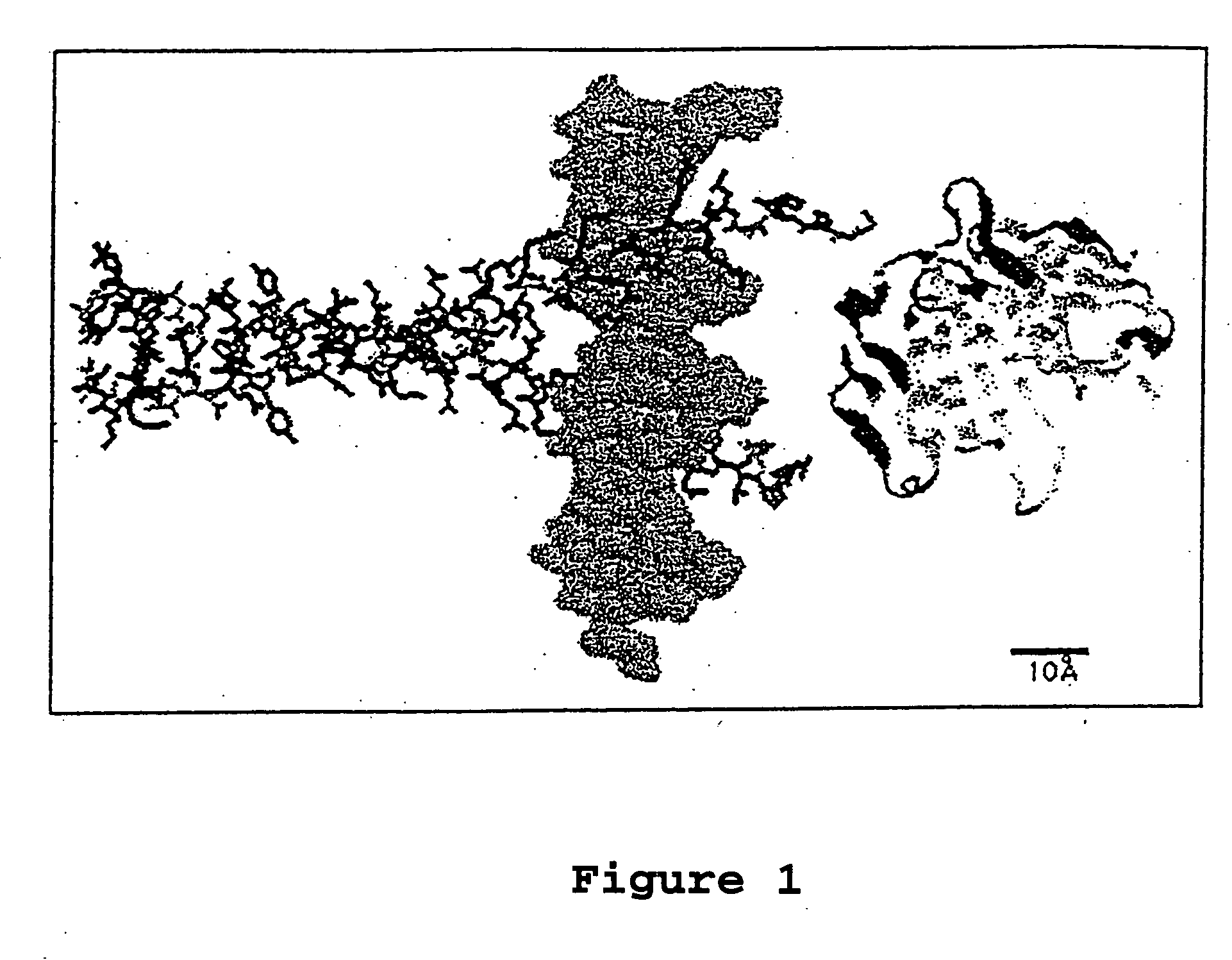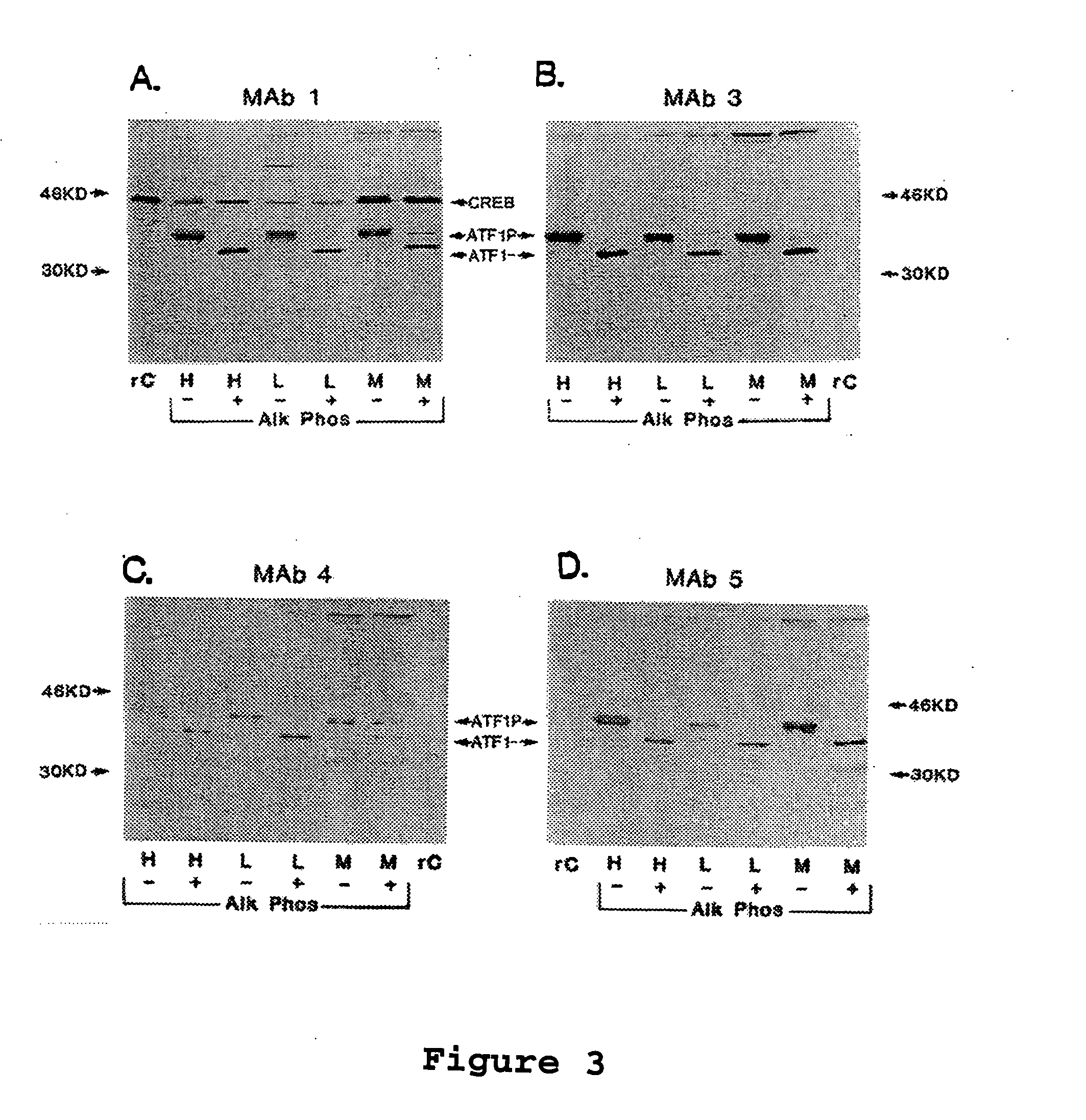Methods and compositions for modulating transcription factor activity
a transcription factor and activity technology, applied in the field of transcription factor pathways, can solve the problems of not being able to demonstrate whether chimeric proteins are essential for continued cell proliferation, or whether other processes have developed that are irreversible, and achieve the effect of increasing the off-rate of transcription factors and preventing their re-binding
- Summary
- Abstract
- Description
- Claims
- Application Information
AI Technical Summary
Benefits of technology
Problems solved by technology
Method used
Image
Examples
example 1
Methods and Material
[0142] The following preparations and methodologies are those utilized in the Examples, unless otherwise indicated.
[0143] Preparation of Recombinant CREB. Recombinant CREB was produced using CREB coding sequences, prepared according to Zhao and Giam (1992). The cDNA for CREB was cloned according to the methodology of Studier et al. (1990), at the NdeI / BamHI sites of the pET-11a expression plasmid. The protein was expressed from the bacteriophage T7 promoter and was purified from Escherichia coli cell lysates on DNA-cellulose columns (Sigma).
[0144] Preparation of Recombinant ATF1. Recombinant ATF1 was produced using expression vectors containing full length ATF1, according to L. J. Zhao and C. Z. Giam (1992). The cDNA for ATF1 was cloned according to the methodology of Studier et al. (1990), at the NcoI / BamHI sites of pET lid. The protein was expressed from the bacteriophage T7 promoter and was purified from Escherichia-coli cell lysates on DNAcellulose columns...
example 2
Characterization of ATF1 MAbs
[0163] The following example demonstrates that MAb1, 3, 4, and 5 react with untreated or alkaline phosphatase treated ATF1 on western immunoblots of nuclear extracts from human and murine cell lines.
[0164] Immunoblotting. The MAb were tested as reagents for immunoblotting. Nuclear extracts (15 μg per lane) from HeLa human cervical epithelioid carcinoma cells (H), L929 murine connective tissue fibroblasts (L), or MT-4 HTLV-1 transformed human T cells (M) were analyzed on 15% SDS-PAGE gels with (+) or without (−) calf intestine alkaline phosphatase (Alk Phos) treatment. rC indicates purified recombinant CREB protein (15 ng per lane).
[0165] Results indicate that all 4 MAb react with untreated or alkaline phosphatase treated ATF1 on western immunoblots of nuclear extracts from human and murine cell lines (FIG. 3). ATF1 also was readily detected in whole cell extracts from established cell lines. Only MAb1 reacted with phosphorylated and dephosphorylated C...
example 3
Binding of ATF1 Mab4 Inhibits DNA Binding
[0167] Double-stranded oligonucleotides used in the electrophoretic mobility shift assays, obtained from Promega were as follows: CRE: 5′-AGAGATTGCC TGACGTCA GAGAGCTAG-3′ (SEQ ID NO:4) (CRE Catalog #E3281), AP1: 5′-CGCTTGA TGAGTCA GCCGGAA-3′ (SEQ ID NO:5) (AP1 Catalog #E3201). DNA binding mixtures (20 μl containing 10-20 ng recombinant ATF1 and / or CREB, 1 μg poly [dI-dC], and 2.5 μg bovine serum albumin in 10 mM Tris, pH 7.5, 50 mM NaCl, 0.5 mM DTT, 0.5 mM EDTA, 1 mM MgCl2, 4% (by volume) glycerol, and 0.035 picomoles 32P-labeled probe) were incubated for 20 min at room temperature, then run on native 4% polyacrylamide gels in high ionic strength buffer (25 mM Tris, 190 mM glycine, 1 mM EDTA) at 4° C.
[0168] DNA binding assays with recombinant ATF1 and CREB (FIG. 4) demonstrated that MAb1 supershifts both ATF1 and CREB complexes to the same extent, and MAb3 shifts CREB a lesser distance than ATF1. MAb4 prevented ATF1-DNA binding, even if it ...
PUM
| Property | Measurement | Unit |
|---|---|---|
| Gene expression profile | aaaaa | aaaaa |
| Affinity | aaaaa | aaaaa |
| Inhibition | aaaaa | aaaaa |
Abstract
Description
Claims
Application Information
 Login to View More
Login to View More - R&D
- Intellectual Property
- Life Sciences
- Materials
- Tech Scout
- Unparalleled Data Quality
- Higher Quality Content
- 60% Fewer Hallucinations
Browse by: Latest US Patents, China's latest patents, Technical Efficacy Thesaurus, Application Domain, Technology Topic, Popular Technical Reports.
© 2025 PatSnap. All rights reserved.Legal|Privacy policy|Modern Slavery Act Transparency Statement|Sitemap|About US| Contact US: help@patsnap.com



